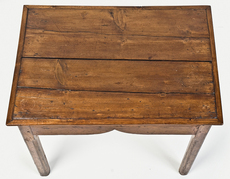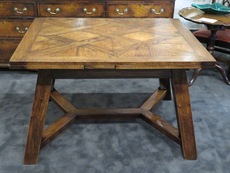THIS ITEM HAS BEEN SOLD
A Unique late 19th Century, French Oak, Art Nouveau, Parquetry Top, Draw Leaf Dining Table
“This table defies simple explanation”
The bold pegged, cleated, solid parquetry top having a large rectangular four seater central section. Unusually, each drawer leaf is of a different size. One being 42cm the other 60cm.
The base, is as unusual as the tops, having a plain central moulded frieze above bold, square, out-swept legs, joined by a ‘Y’ stretcher.
The overall varied depths of colour and patination are due to the unusual geometric feel of this table.
*‘Y’ stretcher is an alternative to the ‘H’ stretcher, enabling chairs to be slid under further, particularly on tables with less overhang, enabling more leg room.
H. 74cm (soon to be 76cm) W. 120cm D. 95cm
Table width with the smaller leaf extended 162.5cm
Table width with the larger leaf extended 180cm
Table width with both leaves extended 222.5cm
1890 – 1910















